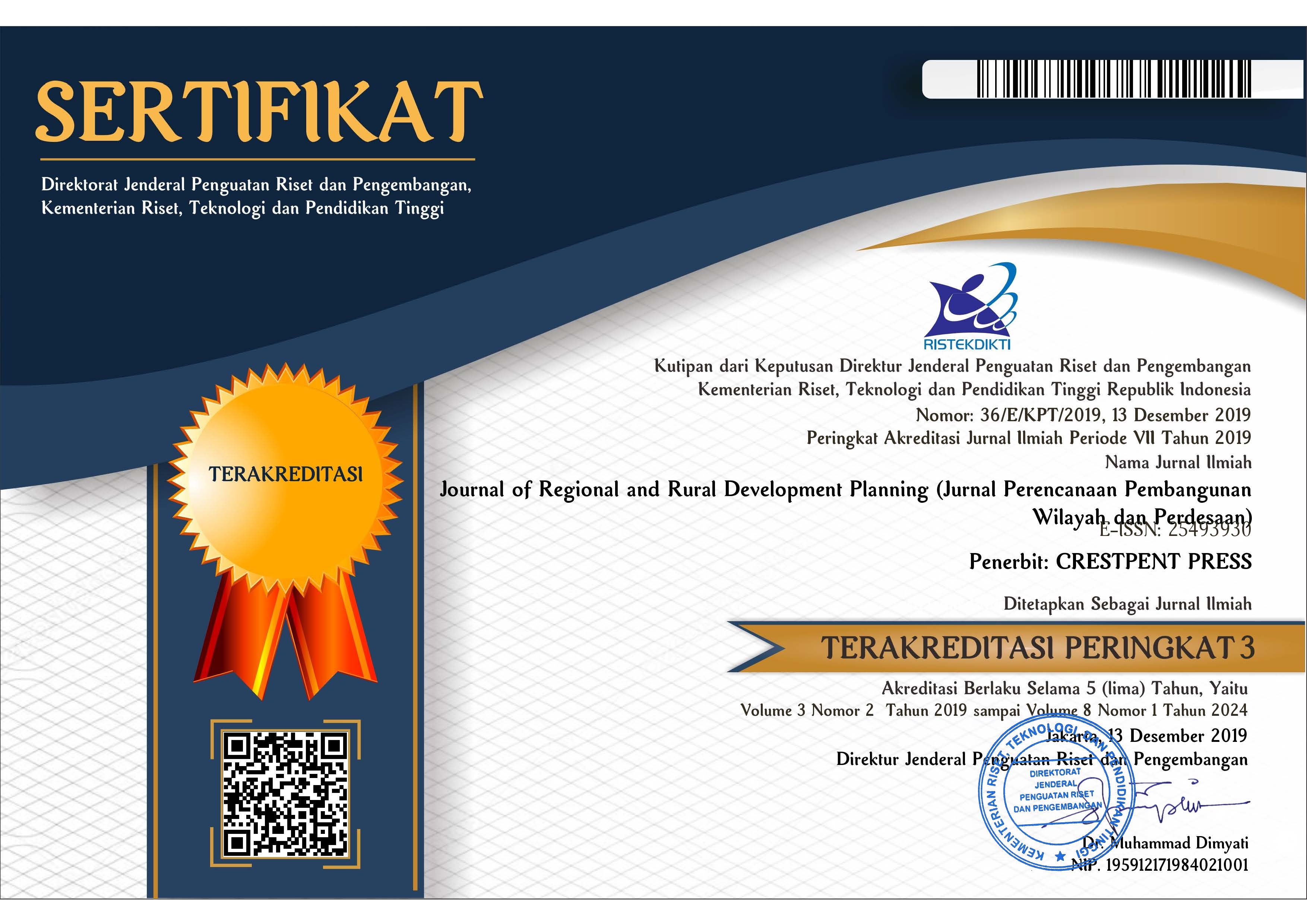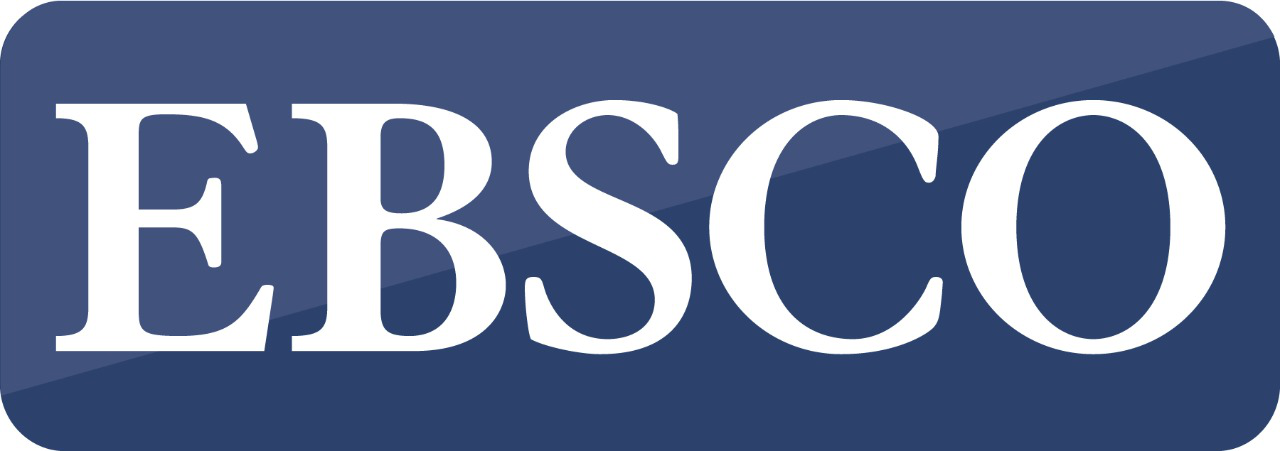Evaluasi Ketersediaan Ruang Terbuka Hijau dan Penerapan Konsep Kota Hijau di Provinsi DKI Jakarta
Abstract
DKI Jakarta Province with a high increase in development activities has implications for the conversion of urban Green Open Space (GOS) into built-up land. The importance of urban GOS can not be separated from supporting the development of the green city. The green city is a concept of realizing a sustainable city and minimizing urban landscape degradation. This research aims to evaluate the availability of urban GOS and the implementation of the green city concept in DKI Jakarta. Geographic Information System (GIS) based spatial analysis methods and remote sensing were used to evaluate the availability of urban GOS. Quantitative and qualitative analysis methods based on the Asian Green City Index (AGCI) are used to evaluate the implementation of the green city concept. The results show that GOS in DKI Jakarta has decreased, from 33.70% in 2000, 23.47% in 2010, and 19.50% in 2020. In the implementation of the green city concept, the performance of DKI Jakarta has increased. Performance in 2000 was at a below-average level (34.58%), in 2010 it was at the average level (44.85%), and in 2020 the performance increased to an above-average level (62.76%). The results showed that the increase in the implementation of the green city concept has not been followed by an increase in the quantity of urban GOS. An integrative urban planning strategy is needed in developing DKI Jakarta and oriented towards the carrying capacity of the landscape and maintaining the availability of urban GOS.
References
Abdul, A., & Hameed, S. (2021). Green Cities and Sustainable Urban Development: (Subject Review). International Journal of Advances in Scientific Research and Engineering (Ijasre), 6(11), 31–36. https://doi.org/10.31695/IJASRE.2020.33929.
ADB. (2004). Water in Asian Cities Utilities’ Performance and Civil Society Views. Asian Development Bank.
Anthony, A. F., Offia, I. E., Abidemi, B. R., Kola, O., & Kamoru, G. (2018). Urban Sustainability Concepts and Their Implications on Urban Form. Urban and Regional Planning, 3(1), 27–33. https://doi.org/10.11648/j.urp.20180301.15.
BPS. (2020). Provinsi DKI Jakarta dalam Angka 2020 [laporan]. Jakarta: Badan Pusat Statistik.
Budiman, A., Sulistyantara, B., & Zain, A. F. (2014). Deteksi Perubahan Ruang Terbuka Hijau pada 5 Kota Besar di Pulau Jawa (Studi Kasus: DKI Jakarta, Kota Bandung, Kota Semarang, Kota Jogjakarta, dan Kota Surabaya). Jurnal Lanskap Indonesia, 6(1), 7–15. https://doi.org/10.29244/jli.2014.6.1.
Dahlia, S., Nurharsono, T., & Rosyidin, W. F. (2018). Analisis Kerawanan Banjir Menggunakan Pendekatan Geomorfologi di DKI Jakarta. Jurnal Alami Jurnal Teknologi Reduksi Risiko Bencana, 2(1), 1–8. https://doi.org/10.29122/alami.v2i1.2259.
Damanhuri, E., & Padmi, T. (2016). Pengelolaan Sampah Terpadu. Bandung: Penerbit ITB.
DIKPLHD. (2020). Dokumen Informasi Kinerja Pengelolaan Lingkungan Hidup Daerah Provinsi DKI Jakarta tahun 2020 [laporan]. Jakarta: Dinas Lingkungan Hidup.
EIU. (2011). Asian Green City Index Assessing the environmental performance of Asia’s major cities. Wittelsbacherplatz 2, 80333 München. [Economist Intelligent Unit].
Hakim, & Endangsih, T. (2020). Evaluation of Environmental Performance Using the Green City Index in Evaluation of Environmental Performance Using the Green City Index in Depok City, Indonesia. Journal of Physics: Conference Series, 1625, 1–11. https://doi.org/10.1088/1742- 6596/1625/1/012001.
Haq, S. A. (2011). Urban Green Spaces and an Integrative Approach to Sustainable Environment. Journal of environmental Protection, 2(5), 601–608.
https://doi.org/10.4236/jep.2011.25069.
Karim, M. Al, Utomo, G. J., & Fauziah, B. (2019). Kualitas hidup dan pertumbuhan ekonomi, studi kasus DKI Jakarta dan daerah penyangganya. Jurnal Pembangunan Wilayah dan Kota, 15(3), 227–247. https://doi.org/10.14710/pwk.v15i3.22287.
Longaris, S., Rogi, O. H. A., Takumansang, E. D., & Ruang, T. P. (2019). Identifikasi dan Evaluasi Eksistensi Ruang Terbuka Hijau di Kecamatan Wenang Kota Manado. Spasial: Perencanaan Wilayah dan Kota, 6(3), 758–768.
Medvedeva, L. B., Komarova, O. P., & Kozenko, K. Y. (2015). Concept – Strategy “ Green Cities ” on the Basis of Medium Industrially Developed Cities of Russia and CIS Countries. European Research Studies Journal, XVIII(3), 41–50. https://doi.org/10.35808/ersj/453.
Mindasari, S., & Rostin. (2015). Evaluasi Program Pengembangan Kota Hijau (Green City) di Kota Kendari. Jurnal Ekonomi Pembangunan (JEP) UHO, 5(2), 49–56.
Noer, R., Fuady, M., & Ridwan, N. (2021). Evaluasi Implementasi Konsep Kota Hijau di Kota Banda Aceh. Jurnal Ilmiah Mahasiswa Arsitektur Dan Perencanaan, 5(4), 49–53.
Rukmana, D. (2015). The Change and Transformation of Indonesian Spatial Planning after Suharto ’ s New Order Regime : The Case of the Jakarta Metropolitan Area. International Planning Studies, 20(4), 350–370. https://doi.org/10.1080/13563475.2015.1008723.
Septriana, F. E., Alnavis, N. B., Gustia, R., Wirawan, R. R., Putri, P., Hasibuan, H. S., & Tambunan, R. P. (2020). Dampak Perubahan Tutupan Lahan pada Sistem Hidrologi di Jakarta. Majalah Ilmiah Globe, 22(1), 51–58. http://dx.doi.org/10.24895/MIG.2020.22-1.1150.
SNI. (2008). Pengelolaan sampah di permukiman. Jakarta (ID): Badan Standardisasi Nasional.
Susanti, Y., Syafrudin, & Helmi, M. (2020). Analisa Perubahan Penggunaan Lahan di Daerah Aliran Sungai Serayu Hulu dengan Penginderaan Jauh dan Sistem Informasi Geografis. BIOEDUKASI: Jurnal Pendidikan Biologi, 13(1), 23–30.
UNDESA. (2018). World Urbanization Prospects: The 2018 Revision. United Nations, Department of Economic and Social Affairs, Population Division.
Wirawan, S. M. S. (2019). Kajian Kualitatif Pengelolaan Air Limbah Domestik di DKI Jakarta. Jurnal Riset Jakarta, 12(2), 57–68. https://doi.org/10.37439/jurnaldrd.v12i2.12.
Zain, A. F. M., Pribadi, D. O., & Indraprahasta, G. S. (2022). Revisiting the Green City Concept in the Tropical and Global South Cities Context : The Case of Indonesia. Frontiers in Environmental Science, 10(787240), 1–14. https://doi.org/10.3389/fenvs.2022.787204.
Copyright (c) 2024 Journal of Regional and Rural Development Planning (Jurnal Perencanaan Pembangunan Wilayah dan Perdesaan)

This work is licensed under a Creative Commons Attribution-ShareAlike 4.0 International License.




.png)














